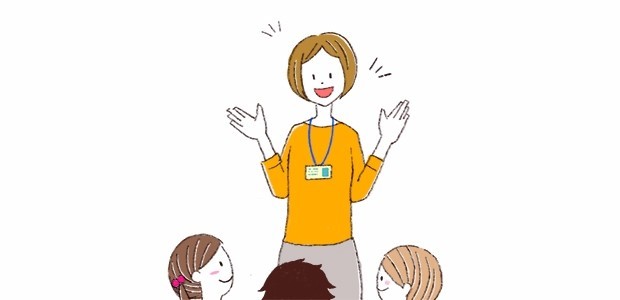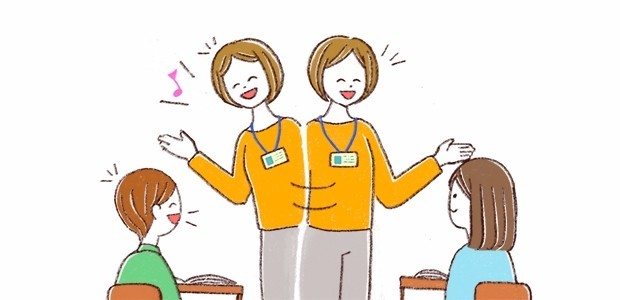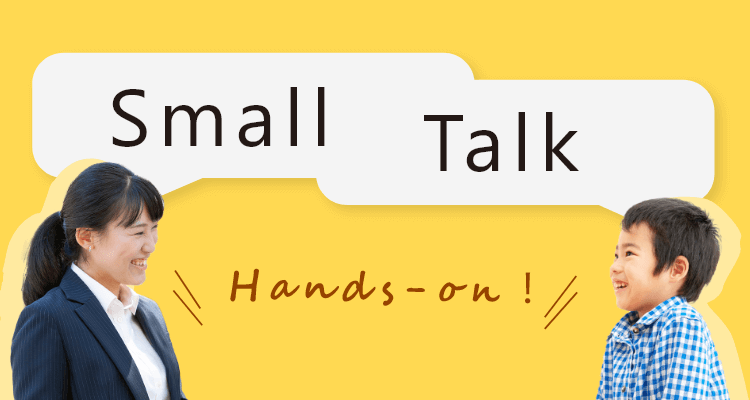小・中#2-1: What do you do first thing in the morning? 朝、何をしますか?(前)
Small Talk ってどうしたらいいの?
児童生徒の発話を引き出す問いかけって?
ここでは、今日の授業ですぐに使える実践例を毎週トピックとともにご紹介します。
小学校5、6年生から中学校はじめまでに学習する表現を使った児童(生徒)とのやり取りの例です。
Small Talk の始め方
Small Talk は、あるトピックについて、これまで学習した語句や表現を最大限に活用して自分の気持ちや考えを伝える言語活動です。その指導は、まず(1)先生がモデルを示す形(「話すこと[発表])、あるいは(2)先生が児童に語り掛け、問い掛けながら発話を引き出す(「話すこと(やり取り)」)形のいずれかで始めることができます。
(1)は児童に使わせたい表現を事前に意識させてから、それらをどう用いるかを見取りたいとき、あるいは学習内容の定着がまだ不十分で、トピックについて自分の思いを適切に表せない児童に、既習表現を効率的に思い出させておきたいときなどに取り入れるとよいでしょう。
一方で(2)は、既習表現がある程度定着している段階で、さまざまな表現を駆使して英語でやり取りを行う力を高めたいときなどに即興的に用いることができます。
今回はこれら2つの形をそれぞれ考えてみたいと思います。
トピックの提示
上記(1)(2)のいずれの形でも、まずはクラス全体に向かって、これから英語で話してもらいたい「トピック」を伝えます。
ただこの時、Today’s topic is ….(今日のトピックは~です)という表現では、ただトピックが与えられただけで、「話してみたい」という動機づけも高まりにくいものです。
次のように児童の興味・関心を高める導入(イントロダクション)の工夫をしてみましょう。
T: What date was last Saturday?
S: April 18th.
T: Yes, that’s right. It was the 18th of April.
Then, do you know what day it is? [What day is it?]
S: ….
T: April 18th …(4、1、8と板書)… four, one, eight … in Japanese?
S: よ、い、は ・・・ 良い歯の日!
T: That’s right. 良い歯の日. Good teeth day!
Do you have good teeth?
S: Yes!
T: Excellent. So, do you brush your teeth every day?
S: Yes. Of course!
T: How many times do you brush your teeth a day?
S: Three ….
T: Three times. (When do you brush your teeth?) You brush your teeth in the morning, after school lunch, and in the evening?
S: Yes.
T: Good. Who brushes four or more times?
S: Yes! / No! / ….
T: Wow. I didn’t know you like brushing your teeth so much. Anyway, good teeth are important. Don’t go to bed before brushing your teeth. Brush your teeth, and (then) go to bed. Okay?
いかがでしょうか。さらにやり取りを広げるために、児童一人一人に「一日に何回歯を磨くか」と尋ねて比べてみてもよいですね。いずれにしても先生が何度も、brush one’s teethという表現を意図的に繰り返して言っています。日々の授業の中でトピック選びに困ったら、「今日は何の日」に関連づけてみるのもよいかもしれません。
今回の話題は「歯を磨こう」・・・よりも少し広げて、「一日の生活」をトピックとして、一日のさまざまな動作を表す表現を用いた対話の展開を考えてみたいと思います。まずは「朝起きてからすること」に絞って例をみてみましょう。
【展開例】(1)先生が自分の「一日の生活」のうち「朝起きてからすること」について話す
ここでは「話すこと[発表]」の領域のモデルとして、先生が「自分は朝起きてから何をするか」についてスピーチ[発表]をしています。上の導入部分で「brush one’s teeth」の話になったので、先生の話もそれと少し連続性を持たせて始まります。
I brush my teeth three times a day.
We do many things every day.
In the morning, from Monday to Friday, I usually get up at five thirty. I feed my cat – make breakfast for my cat first thing in the morning. Second, I wash my face and comb my hair. At around six, I have breakfast. Then, I wash the dishes and brush my teeth. I get ready for work and, finally, leave home at ten past seven. This is my morning routine.

単に先生が朝起きてから何をするかを羅列しているのではなく、する順番に話していることを明確に伝えるために、First, …. Second, …. Then などの副詞や、具体的な時間を含めて伝えています。その後の対話の発展においても、「順番」がキーワードとなります。
【展開例】(2) 先生が「朝にすること」について児童に語りかけ、問いかけながらまとめる
《その1:「朝起きて一番最初にすること」に焦点》
先生がまず「自分が何時に起きるか」を伝え、S1、S2、S3の児童に次々に問い掛けていきます。その際、児童には「起きてから最初にすること」も尋ねます。
大切なのは、前の児童が答えたことを受け止めて、次の児童とその内容を共有しながら対話を進めること。これがなければ単に「1対1」の機械的なやり取りで終わってしまいます。さらに、児童の発話を「文の形で」きちんと言い直して聞かせることです。
T: I usually get up at five thirty. (How about you?) What time do you usually get up, S1?
S1: Seven.
T: Oh, you usually get up at seven. (I leave home for work at ten past seven ….) What’s the first thing you do in the morning?
S1: Wash face …
T: You wash your face first. I see. Thank you, S1.T: Hi, S2. I usually get up at five thirty. S1 usually gets up at seven. What do you usually get up?
S2: I get up at six thirty.
T: You get up at six thirty. Then, what’s the first thing you do in the morning?
S2: I brush my teeth.
T: You brush your teeth first. OK. Thank you, S2.
T: Hello, S3. How are you? I feed my cat – make breakfast for my cat first thing in the morning. S1 washes his face first. S2 brushes her face first. What’s the first thing you do in the morning?
S3: I eat breakfast.
T: You eat breakfast first. Oh, everyone is different.

《その2:「朝起きて最初にすることを3つ」に焦点》
こちらのパターンでは朝起きてからすることを、順番に1つずつ聞き出していきます。
大切なのは「順番」を伝えるのに必要な表現が使われていることを、少し大げさにジェスチャーなどを添えることで「気付かせていく」ことです。何人かの児童に尋ねていくなかで、児童の方から first、second などの語を自発的に使うようになることを期待するものです。
T: I usually get up at five thirty. (How about you?) What time do you usually get up, S1?
S1: Seven.
T: Oh, you usually get up at seven. What’s the first thing you do in the morning?
S1: Wash face …
T: You wash your face first. I see. What do you do next?
S1: I have breakfast
T: What do you do after that?
S1: Brush my teeth.
T: I see. In the morning, first, you wash your face. Second, you have breakfast. Then, you brush your teeth. Thank you, S1.T: Hi, S2. What are the first three things (you do) in the morning? (First , …?)
今回は、「朝起きてからすること」というトピックについて、その導入後の展開例として「先生が自分の朝のルーティンについて児童全体に話す」や、「朝、最初にすることをより多くの児童に問い掛ける」、さらに「朝することのうち、最初の3つに絞って順番に引き出す」という3つを紹介しました。
【発話モデルに意図的に含めた表現】
I brush my teeth three times a day.
(私は一日に3回歯磨きをします)
⇒ How many times do you brush your teeth?
(一日に何回歯を磨きますか)*回数に焦点を当てた展開で使える表現です。
From Monday to Friday, I usually get up at five thirty.
(月曜日から金曜日は、たいてい5時半に起きます)
*usually を入れることで「毎日決まった時間に起きるわけじゃないし~」「学校がない日は違うんだけど」と戸惑う児童が減りますね。
そのため、児童に起きる時間を尋ねるときにも
What time do you usually get up?
と言ってみるとよいでしょう。
I sometimes get up at six, but I usually get up at seven.
くらいの使い分けができるようになるとよいですね。ほかにも never、alwaysなどを取り入れて話すことができます。I feed my cat – make breakfast for my cat first thing in the morning.
(朝一番にペットの猫の朝ご飯を作ります)
*feed(食物を与える、餌を与える)が難しいので、児童に親しみのある表現で言い換えています。
*first thing in the morning「朝一番に(朝一で)」は副詞的に使われます。今回は「朝、最初にすることは何ですか」と尋ねる時に、What’s the first thing you do in the morning? を使っています。Second, I wash my face and comb my hair.
(2番目に、顔を洗って髪をとかします)
*do one’s hair「髪を(アレンジして)整える」もあります。
At around six, I have breakfast.
(6時頃に、朝食を食べます)
*「1番目に、2番目に・・・」と続くと単調なので、時間の流れを明確にしてみました。Then, I wash the dishes and brush my teeth.
(それから、皿洗いをして、歯を磨きます)
I get ready for work and, finally, leave home at ten past seven.
(仕事に行く支度をして、ようやく、7時10分に家を出ます)
*順番を表すために副詞を効果的に組み込みます。
同様に「一日の生活」を表す語句や表現を使いながら、今度は「家に帰ってからすること」と「寝る前にすること」のそれぞれに焦点を当てて、対話を展開させることもできそうです。
トピック導入からどのような流れが考えられるでしょうか。ぜひ考えてみてください。本サイトでも次の記事(4月21日更新予定)にてご紹介します。
Small Talk の指導にあたっては、その段階までに児童の既習事項がどれくらいあるかを把握したうえで、それらを単語だけとか、主語がない形で言って終わりではなく、「きちんとした文」となるように整えて話すように児童を促しましょう。先生のそうした細やかな配慮が、児童にとっては英語表現のさらなるインプットになるのです。



